Over the last few years, you have probably seen a lot more personal injury law firms advertising, “Truck Wreck?” As one might expect, the increased advertising is likely fueled by an increase in large, semi-trailer truck wrecks and related injuries, and deaths. So, what exactly is “UP” with truck wrecks, and why?

The high-level summary answer is that there are more freight-hauling trucks on the road and more overall vehicle accidents. Accordingly, there are more truck-related wrecks. The rise in truck wrecks is particularly alarming because collisions involving trucks result in more fatalities and critical injuries due to the size, weight, and design of trucks.
From the perspective of truck collision experts, the answer is more complex. There are deeper root causes and avoidable risk factors. So, from a more technical perspective: Why are there more trucks? Why do truck wrecks result in higher numbers of severe injuries and deaths?
Let’s address these questions in three parts:
- Presence: Trucks are big and heavy, and a growing economy puts more of them on the road.
- Design: The “underride” potential of many U.S. semi-trucks increases the likelihood of severe injuries and the probability of death.
- Collisions: For many reasons, particularly increased distracted driving, there are more accidents, more fatalities, and a greater likelihood of truck wrecks.
- Increased Presence: Trucks are Big, Heavy, and Increasing in Numbers Relative to Economic Growth.
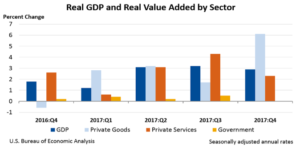
“Follow the money” is a good, general clue to find the root cause of most trends. Take a look at the current growth of private goods. The U.S. economy is growing, with more “private goods” being purchased. A large part of the increase involves goods purchased online – which require individual shipping – which means domestic freight is up. Large trucks carry about 70% of U.S. freight. According to RoadScholar.com, freight-carrying trucks are expected to grow at 3% per year through 2023, hauling about 10.5 billion tons per year. It follows that truck-hauling growth trends with economic growth, which was 2.9% in the fourth quarter of 2017. Commercial growth is higher in larger metropolitan areas. We, therefore, see higher relative growth in the number of trucks on the most heavily trafficked interstates – where every 4th vehicle is likely to be a freight-hauling, semi-trailer truck.
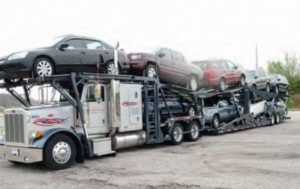 With 18-wheeler freight trucks weighing between 40,000 and 80,000 lbs., compared to about 3,200 lbs. for cars … you see where this is going. Even if overall vehicle accidents stayed constant (although they are increasing as well), the likelihood of a truck accident is increasing simply because more trucks are on the road. Theoretically, you could curtail the number of truck collisions by curtailing economic growth, but we do not think anyone advocates that solution. After all, economic growth is a good thing. Instead, the focus must be making interactions between trucks and automobiles safer. In an accident with a truck, the likelihood of serious injury and death increases for several reasons. Some are obvious (i.e. vast difference in size, weight. . . mass), but some are not so widely known.
With 18-wheeler freight trucks weighing between 40,000 and 80,000 lbs., compared to about 3,200 lbs. for cars … you see where this is going. Even if overall vehicle accidents stayed constant (although they are increasing as well), the likelihood of a truck accident is increasing simply because more trucks are on the road. Theoretically, you could curtail the number of truck collisions by curtailing economic growth, but we do not think anyone advocates that solution. After all, economic growth is a good thing. Instead, the focus must be making interactions between trucks and automobiles safer. In an accident with a truck, the likelihood of serious injury and death increases for several reasons. Some are obvious (i.e. vast difference in size, weight. . . mass), but some are not so widely known.
- Increased Risk of Wrongful Death by Design: Be Aware of the “Side-Underride”.
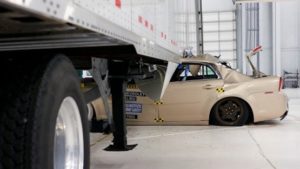 This image (at right) is of a crash test simulating a “side underride” truck wreck. So, what is an underride accident? An underride occurs when an automobile crashes into the side or the rear of a semi-truck, and the automobile “rides under” the semi-truck. In an “underride” collision, the risk of serious injury and death increases exponentially. Quite literally, hitting a brick wall is safer than hitting a semi without an underride guard from an “underride” angle. When an automobile strikes a brick wall or the rear or side of a comparably sized vehicle, the automobile’s “crash cage”, various crumple zones, and solid engine block are designed to prevent passenger compartment intrusion. In an underride collision, these safety mechanisms are powerless. It is the passenger compartment intrusion which causes fatal injuries and, in many cases, decapitation.
This image (at right) is of a crash test simulating a “side underride” truck wreck. So, what is an underride accident? An underride occurs when an automobile crashes into the side or the rear of a semi-truck, and the automobile “rides under” the semi-truck. In an “underride” collision, the risk of serious injury and death increases exponentially. Quite literally, hitting a brick wall is safer than hitting a semi without an underride guard from an “underride” angle. When an automobile strikes a brick wall or the rear or side of a comparably sized vehicle, the automobile’s “crash cage”, various crumple zones, and solid engine block are designed to prevent passenger compartment intrusion. In an underride collision, these safety mechanisms are powerless. It is the passenger compartment intrusion which causes fatal injuries and, in many cases, decapitation.
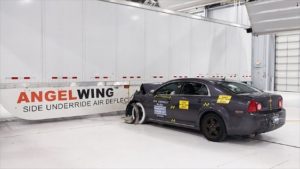 Due to the danger presented by the “underride”, rear-underride guards are already required in the United States, but there is debate over the strength of the current requirements. While there is at least some requirement of a rear-underride guard, there is no requirement for a side-underride guard, which would help prevent side-underride, as depicted in this crash test image (at left). Is the lack of a side underride guard wrongful death by design?
Due to the danger presented by the “underride”, rear-underride guards are already required in the United States, but there is debate over the strength of the current requirements. While there is at least some requirement of a rear-underride guard, there is no requirement for a side-underride guard, which would help prevent side-underride, as depicted in this crash test image (at left). Is the lack of a side underride guard wrongful death by design?
Kentucky’s wrongful death statute is much like that of other states: “If the acts or omissions of another person or company constitute a substantial factor in causing someone’s death, the deceased’s survivors can assert a claim.” The applicable term in this situation is “omission.” The omission is this: side-underride-protection guards on semi-trucks are known to reduce and prevent death and decapitation in car collisions. Yet, they are not required in the U.S.
Let us be clear on something before we move forward. The lack of a specific law requiring side-underride protection guards does not mean that a truck company is not negligent for failing to use a side-underride protection guard. The law makes a distinction between basic negligence and “negligence per se.” Everyone – including truck companies – has a duty to exercise reasonable care. In a basic negligence case, a company is negligent if a reasonable company would have done something different (i.e. added an underride guard). If a truck company fails to use a side-underride guard and a side-underride guard could have prevented someone’s death, it is a strong indication of negligence – even in the absence of a statute – because a jury could believe a “reasonable” company would install side- underride guards. If, however, a law specifically required side-underride guards, and someone died in a collision – and a side-underride guard would have prevented the death, the truck company is “negligent per se”. If the company is “negligent per se”, that means no further proof of negligence is necessary. When looking at “negligence per se” there is no question of what a reasonable company would have done. The company is per se negligent if the law requires something which it failed to do. So, while the lack of a law is not fatal to a side-guard related negligence claim, a law would certainly help protect the American public.
- “A 2012 IIHS study found that strong side underride guards have the potential to reduce injury rates in about three-fourths (3/4ths) of large truck side crashes producing a fatality or serious injury to a passenger vehicle occupant. This proportion increased to almost 90 percent when restricted to crashes with semi-trailers.
- As noted above, federal law requires large trucks to have rear underride guards but not side underride guards. At least three U.S. cities — Boston, New York and Seattle — mandate side guards on city-owned and/or contracted trucks as part of Vision Zero initiatives to eliminate crash deaths and injuries, particularly among pedestrians and bicyclists.”
Why aren’t side-underride guards required in the U.S.? Again, “follow the money.” The trucking industry has so far been successful in maintaining that the cost of installing side-underride guards outweighs the risks. The family members of people killed due to the lack of side-underride guards beg to differ. As victims of these preventable deaths, surviving family members are pushing for legislation. See this NPR story of the Roya, Anna Leah & Mary Comprehensive Underride Protection Act of 2017.
- Increase in Accidents: Most Causes Are Preventable with Focused, Careful Driving.
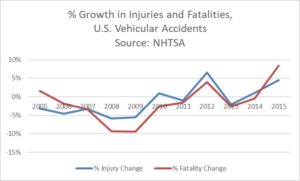 The most obvious – but frustratingly avoidable – root cause of increased truck wrecks (and related injuries and deaths) is the increase in all motor vehicle collisions. More trucks plus more wrecks equals more truck wrecks. It will not come as a surprise to anyone that the rise in collisions trends with the rise in cellphone ownership. But, let’s not forget the other top, historic causes of wrecks, namely, speeding, drunk driving, and the lack of careful driving in bad weather and darkness.
The most obvious – but frustratingly avoidable – root cause of increased truck wrecks (and related injuries and deaths) is the increase in all motor vehicle collisions. More trucks plus more wrecks equals more truck wrecks. It will not come as a surprise to anyone that the rise in collisions trends with the rise in cellphone ownership. But, let’s not forget the other top, historic causes of wrecks, namely, speeding, drunk driving, and the lack of careful driving in bad weather and darkness.
Top 7 Causes of Car Accidents in 2018
- Speeding
- Drunk driving
- Distractions
- Cell phones
- Weather
- Disregarded red lights
- Time of day
Also, remember that truck drivers face the additional risk of driving drowsy due to pulling long shifts and driving faster to meet tight delivery deadlines.
What can be done to prevent truck wrecks and related injuries and fatalities?
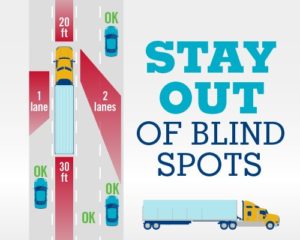
Drive carefully. You must make defensive driving and awareness of large trucks a priority. Even if you think you are already aware, increase your awareness. Many precautions when driving around trucks aren’t all that obvious, so take a look at these helpful Tips for Driving Safely Around Large Trucks or Buses, by the Department of Transportation.
Most important among these tips: give trucks space, and stay out of their blind spots. If you see truck drivers driving dangerously, don’t hesitate to call that number posted on the back of them … but not while you’re driving!
At DeCamillis & Mattingly, we strive to be a community resource for prevention as well as a community resource for the representation of victims of accidents, injuries, and wrongful death. We hope these posts are useful, and please bring any research interests and/or input to our attention. Drive safely.


